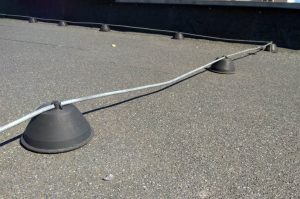CONVENTIONAL LIGHTNING PROTECTION
The conventional lightning arrester consists of Franklin rods. Their effectiveness is decided based on their position, morphology, materials used, and physical reaction that is performed due to the electrostatic field during the lightning.
The lightning arrester is placed at a dominant height, making it a favorable point for the lightning bolt to strike. Through the grounding system, the positive charge rises to the tip of the lightning rod. And when the lightning strikes, the device allows the lightning leader from the cloud and grounds it safely through the installed grounding system. Hence the current discharge gets distributed evenly throughout the ground and thus protects the structure.
The conventional lightning protection system is called a passive air terminal and the designing for the same is carried out based on IS/IEC 62305 part 3. The other type of air terminal is an active type of air terminal for which the design will be carried out based on NFC 17-102. Whether to design lightning protection system as per the conventional IEC 62305 standards or by following the modern French NFC 17-102 standard, we are unbiased.

The probability of a structure being struck by a lightning flash can be greatly reduced by a properly designed air termination system.
The position of the air termination system shall be designed by using the following placement methods as specified by IS/IEC 62305-3.
As per IEC 62305 there are three methods to design conventional lightning protection system which are as follows
-
Protection Angle Method
Protection Angle Method or Cone of Protection Method is the traditional method of protecting the structures from lightning strikes. It is suitable for simple shaped buildings. It also has limitations on the height of the air terminal
-
Rolling Sphere Method
In the Rolling Sphere Method, the air termination system shall be positioned by rolling a sphere of radius around and on top of the structure to be protected in all possible directions. Rolling Sphere method shall be used for all types of buildings.
-
Mesh Method
Mesh Method of lightning protection is suitable for structures with flat surfaces and sheds having slope less than 1/10. The size of the mesh depends on the class of LPS and protection level requirements.
FEATURES
The probability of a structure being struck by a lightning flash can be greatly reduced by a properly designed air termination system along well developed and strengthened components uses.
There comes the importance for LSG PROTECT Conventional system, our research and development wing with the support of worlds most sophisticated high voltage laboratories make sure about the strength of our products being supplied, and also we make sure that we follow international standards without any compromise. For us its safety first.
FEATURES AND BENEFITS
- Blunt tip – To strengthen the electric field energy at the tip of the air terminal
- Sufficient mechanical strength
- Higher current carrying capacity
- High melting point
- Long life
- Tested as per IEC 62561-2 for short circuit current carrying capacity.
PRODUCTS
LSG PROTECT manufactures an exclusive range of conventional lightning protection components for residential, commercial, and industrial buildings.
All of our products are made from high-quality materials with strict quality assurance procedures to ensure that all of our parts will perform to specification and provide many years of worry-free service.
- Heavy Duty Mounting Brackets
- Mounting Brackets
- Air Terminal Bases & Adapters
- Air Terminal Braces
- Connectors & Fittings
- Clamps, Straps, Connectors, Fasteners, and Hardware
- Air Terminals Elevation Rods & Base Metric Systems
- Saddle Rod Brackets & Coupling Metric System

